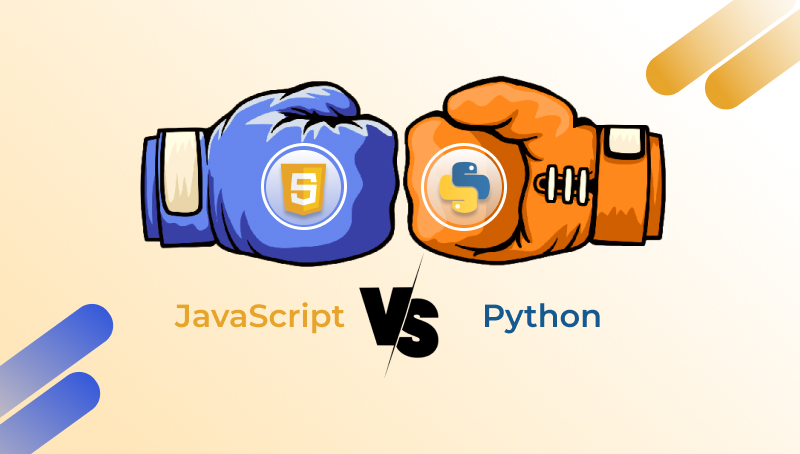In the world of programming, the choice of language can significantly impact your development journey. JavaScript and Python stand out as two widely embraced programming languages and each has distinctive strengths and applications.
In this blog, we will delve into the features, advantages, and characteristics of JavaScript and Python, compare the two, and discuss their future prospects. So, whether you are a seasoned developer or a beginner looking to embark on your coding adventure, read on to discover the differences and similarities between these two versatile languages.
What is JavaScript?
JavaScript is a dynamic and versatile high-level scripting language, primarily harnessed for web development. It plays a pivotal role in enhancing websites by introducing interactivity and advanced functionality, making it an essential component of front-end development.
Features of Javascript
1. Versatility: JavaScript is not limited to web development; it can be used on both client and server sides. This flexibility allows it to be employed in various contexts, from building web applications to server-side scripting.
2. Lightweight: The language itself is lightweight, and you don’t need any special setup to start coding. JavaScript is accessible to both developers and users due to its universal support across all major web browsers.
3. Fast Execution: JavaScript is executed on the client’s browser, providing instant feedback to users. This real-time interactivity is a key reason for its popularity in web development.
4. Extensive Libraries and Frameworks: There are numerous libraries (e.g., jQuery) and frameworks (e.g., React, Angular) available to simplify development. These tools provide pre-built functionality, speeding up the development process.
Advantages of Javascript
1. Interactivity: You can construct dynamic and interactive web applications with JavaScript. You can build features like sliders, forms with real-time validation, and interactive maps.
2. Wide Browser Support: JavaScript enjoys compatibility with all prominent web browsers, ensuring that your code can operate seamlessly on a diverse array of devices and platforms.
3. Large Community: JavaScript has a vast online community, offering support, resources, and a plethora of open-source projects. This neighborhood-based strategy encourages creativity and problem-solving.
4. Speed: JavaScript can be incredibly fast when optimized properly. Modern JavaScript engines, like V8 in Chrome, have made significant performance improvements, making web applications responsive and smooth.
Your First Javascript Program
Here’s a simple JavaScript program that greets the user with a pop-up message:
function greet(name) {
console.log("Hello, " + name + "!");
}
greet("World");Characteristics
1. Weakly typed: JavaScript follows weak typing, eliminating the requirement to explicitly declare variable data types. Although this flexibility can be advantageous, it also brings the potential for unforeseen behaviors if not managed with care.
2. Asynchronous: JavaScript operates with a single thread, but it offers support for asynchronous programming through mechanisms such as callbacks, promises, and async/awaits. This capability is vital for managing tasks like network requests without causing interruptions to the user interface.
3. Prototypal Inheritance: JavaScript follows a prototypal inheritance model for object-oriented programming. Objects can inherit properties and methods from other objects, enabling a dynamic and flexible way of defining classes and objects.
Code Snippets For Javascript
Here’s an example of a JavaScript function that calculates the sum of two numbers:
function addNumbers(num1, num2) {
return num1 + num2;
}
// Usage
let result = addNumbers(5, 3);
console.log("The sum is: " + result);JavaScript’s versatility and wide range of applications make it a valuable skill for web developers, and its constant evolution ensures its continued relevance in the ever-changing world of web development.
What is Python?
High-level and multifunctional, Python was created by Guido van Rossum in 1991 and is renowned for its readable and easy-to-use interface. It has garnered favour for its simplicity and adaptability and is extensively employed in a range of domains, such as web development, data analysis, scientific research, artificial intelligence, and beyond.
Features of Python
1. Readability: Python’s clean and easy-to-read syntax is one of its most significant advantages. Its code structure relies on indentation, making it visually appealing and improving code consistency.
2. Versatility: Python can be used for web development (with frameworks like Django and Flask), data analysis (with libraries such as Pandas and NumPy), scientific computing (SciPy), machine learning and artificial intelligence (TensorFlow, PyTorch), and more. Its broad range of applications is a testament to its adaptability.
3. Extensive Libraries: Both the standard and third-party libraries for Python are quite extensive. This extensive collection of modules simplifies and accelerates development, as many common tasks are readily supported.
4. Cross-Platform: Python can be used on multiple operating systems, including Windows, macOS, and Linux, due to its cross-platform nature. This portability ensures that Python code can be used in different environments.
Advantages of Python
1. Beginner-Friendly: Python’s simple and readable code is perfect for beginners. It enables beginners to concentrate on fundamental programming principles instead of becoming entangled in intricate syntax complexities.
2. Productivity: Python’s code is succinct and expressive, empowering developers to accomplish more with fewer lines of code. This efficiency can greatly enhance development speed while diminishing the chances of errors.
3. Community: Python benefits from a sizable and dynamic community that consistently plays a pivotal role in its ongoing development and expansion. This community results in vast resources, support forums, and numerous open-source projects.
4. Versatility: Python is easily integrated with C, C++, and JavaScript, among other languages. This makes it a valuable tool for projects requiring diverse language components.
Your First Python Program
Here’s a basic Python program that greets the user with a message:
# Display a greeting
def greet(name):
print("Hello, " + name + "!")
greet("World")Characteristics
1. Strongly Typed: Python is a strongly typed language, which means you must explicitly define the data type of a variable. This feature helps reduce the likelihood of errors by ensuring type consistency.
2. Synchronous: It focuses on structuring and organizing code using classes and objects. However, it supports asynchronous programming when needed.
3. Class-Based Object-Oriented Programming: Python follows a class-based model for object-oriented programming. It emphasizes the use of classes and objects to structure and organize code.
Code Snippet For Python
Here’s an example of a Python function that calculates the sum of two numbers:
def add_numbers(num1, num2):
return num1 + num2
# Usage
result = add_numbers(5, 3)
print("The sum is:", result)Python’s simplicity and broad utility make it a fantastic choice for both beginners and experienced programmers. Its rich ecosystem of libraries and its ability to excel in a wide range of applications ensure its relevance and continued growth in the programming world.
Comparison Between JavaScript & Python
JavaScript and Python are two popular programming languages, each with its own strengths and use cases. Let’s compare these languages in various aspects:
- Popularity and Use Cases
JavaScript: JavaScript is the fundamental language of the web, used extensively in web development to provide webpages with greater functionality and interactivity. It’s also increasingly used on the server side (Node.js).
Python: Web development, data analysis, scientific computing, machine learning, artificial intelligence, and many other fields can all benefit from the flexibility of Python. It is known for its readability and is often used for scripting and automation.
- Syntax and Readability
JavaScript: JavaScript’s syntax can be flexible, which may lead to less readable code. However, modern JavaScript and ES6 features have improved readability.
Python: The straightforward, readable syntax of Python is one of its key advantages. Code chunks are indicated with indentation to enforce a uniform coding style.
- Performance
JavaScript: JavaScript is typically faster for specific tasks, especially in web development, because it runs directly in web browsers. The performance of modern JavaScript engines, such as V8, has significantly improved.
Python: Python is generally slower than JavaScript but is optimized for development speed. It is not considered a language for high-performance computing.
- Community and Resources
There are sizable and vibrant communities for Python and JavaScript. You can find extensive resources, libraries, frameworks, and support for both languages.
- Learning Curve
JavaScript: JavaScript can be challenging to learn for beginners, especially due to asynchronous programming concepts.
Python: Python is frequently regarded as more accessible to learn, thanks to its clear and readable syntax. It is a great language for beginners.
- Versatility
JavaScript: It is predominantly employed in web development but can also serve as a server-side language through Node.js.
Python: One of Python’s notable strengths lies in its versatility, as it finds application in diverse domains, ranging from web development to scientific research and machine learning.
Difference between Python and JavaScript
| Aspect | JavaScript | Python |
| Primary Use | Web development (client & server side) | Web development, data analysis, scientific computing, machine learning, automation |
| Syntax and Readability | Flexible, potential for less readable code | Clean and highly readable, enforced by indentation |
| Performance | Faster for web development tasks (runs in browsers) | Generally slower, optimized for development speed |
| Community and Resources | Large and active community, extensive libraries and frameworks | Large and active community, rich standard library, numerous third-party libraries |
| Learning Curve | Can be challenging for beginners, asynchronous programming concepts | Easier to learn due to clean syntax, suitable for beginners |
| Versatility | Primarily used for web development, increasingly on the server side | Versatile, used in various domains, including web development, data analysis, AI, scientific computing |
| Asynchronous Programming | Widely used, supports callbacks, promises, async/await | Supports asynchronous programming when needed |
| Object-Oriented Approach | Prototypal inheritance model for object-oriented programming | Class-based model for object-oriented programming |
Future of JavaScript and Python
JavaScript
JavaScript’s future is promising, with the following key developments:
1. WebAssembly (Wasm): WebAssembly allows running languages other than JavaScript in web browsers, opening new possibilities for web applications.
2. Modern Frameworks: The development of modern JavaScript frameworks like Vue.js, Angular, and React continues to improve the developer experience and user interactivity.
3. Server-Side Dominance: Node.js has gained significant popularity on the server side, and its growth is likely to continue.
4. Web APIs: JavaScript continues to evolve with new web APIs and technologies for better integration with hardware, enhancing web applications’ capabilities.
Python
Python’s future is bright, driven by the following trends:
1. Machine Learning and AI: In the domains of artificial intelligence and machine learning, Python is commonly acknowledged as the preferred language. Advancements in these domains are being actively contributed to by libraries like sci-kit-learn, PyTorch, TensorFlow, etc.
2. Web Development: Python is a good option for web developers because frameworks like Django and Flask are growing in popularity.
3. Data Science and Analysis: Python remains a dominant language for data science and analysis, with libraries such as Pandas and NumPy.
4. Education: Python’s simplicity and readability make it a popular language for teaching programming, ensuring a steady stream of new Python developers.
5. IoT and Automation: Python’s ease of use makes it a favourite for IoT projects and automation, contributing to its continued growth.
Both JavaScript and Python have bright futures. JavaScript’s continued dominance in web development and server-side applications, along with Python’s versatility and prominence in data science and machine learning, make both languages essential tools for developers in various domains.
Conclusion
In the Python vs JavaScript for web development battle, there’s no one-size-fits-all answer. The decision you make between these languages will rely on the project at hand, your preferences, and your unique demands.
JavaScript is your go-to choice for web development, while Python excels in data science, AI, and other fields. Your programming journey might even involve learning and using both languages to harness their full potential. So, choose wisely, embrace the versatility of these languages, and embark on your coding adventure with confidence.
FAQs
Ans. High-level languages like Python and JavaScript share many similarities, yet they differ greatly in terms of syntax, use cases, and execution environments. Python is often considered more readable and beginner-friendly, while JavaScript is geared towards web development and interactivity.
Ans. Many developers find Python easier to learn and use, thanks to its clean syntax and readability. However, the ease of learning depends on individual preferences and goals.
Ans. In general, JavaScript is faster for specific tasks, particularly in web development, due to its execution in browsers.
Ans. Because JavaScript is the web’s core programming language, it is the preferred option for web development. While web development can be done with Python (e.g., with Django or Flask), it’s not as commonly associated with this field as JavaScript.







